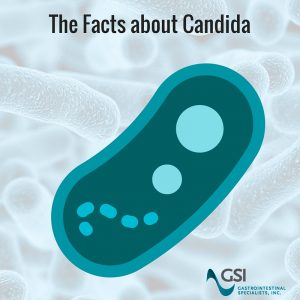News & Events
Candida: What is it and how does it affect you?
Candida: What is it and how does it affect you?
What is Candida?
To put it simply, Candida, or “Candidiasis”, is a fungus. Everyone has a bit of Candida living in their mouth and intestines. The main purpose of this fungus is to aid in digestion and nutrient absorption. However, sometimes this innocuous fungus of the digestive tract grows rampant and causes problems in other areas of the body.
There are a variety of ways Candida affects us. As aforementioned, some of these ways are helpful, but others are a hindrance or even an extreme detriment to our health.The three kinds of effects are:
- Oral Thrush
- Vaginal Yeast Infections
- Invasive Candidiasis
Oral Thrush
Oral Thrush is the common name for “Oropharyngeal” or “Esophageal” Candidiasis. This variety of candida that, when in great amounts, will negatively affect the mouth and throat. According to the Mayo Clinic, Oral Thrush will present itself as “creamy white lesions, usually on your tongue or inner cheeks.” More advanced cases of Oral Thrush can also spread to your tonsils and gums.
Oral Thrush is most likely to affect infants, toddlers, and persons with a weakened immune system such as HIV, AIDS, patients undergoing chemotherapy, radiation, or other cancer treatment, those who have recently undergone some form of organ transplant, and avid smokers are all factions at risk of Oral Thrush.
Vaginal Yeast Infections
Unfortunately, the Mayo Clinic states that 75% of women will experience a Vaginal Yeast Infection at least once in their lives. Vaginal Yeast Infections, or “vaginal candidiasis”, is our next example of what happens when there is too much candida in the body. As most women can tell you, a Vaginal Yeast Infection is an incredibly uncomfortable experience. Symptoms include itching and irritation of the vagina and vulva and a thick cottage cheese-like discharge.
The Mayo Clinic also tells us that the causes of Yeast Infections are more varied than Oral Thrush; however, both conditions can find commonality in affecting those with weakened immune systems. Yeast Infections also often affect pregnant women, diabetics, and women who are taking medicine for oral contraception or hormone therapy.
Invasive Candidiasis
Invasive Candidiasis occurs when Candida enters the bloodstream. We learned from the CDC that Invasive Candidiasis is often a result of long-term hospitalization. Invasive Candidiasis symptoms include fever and chills and resistance to antibiotic medications. At this juncture, the infection is far more serious than either Oral Thrush or Vaginal Yeast Infections. The danger is only exasperated in that most patients suffering from Invasive Candidiasis are in the process of recovering from or have some other serious ailment.
The Takeaway
A little bit goes a long way. At its least threatening, Candida is a helpful and healthy aspect of normal digestion. However, this is an instance in which you may absolutely have too much of a good thing. The in-between is mostly discomfort. People often find simple relief by changing their diet and general health habits. If you feel you may be experiencing these symptoms as they relate to Candida, contact your doctor. Together you can find a solution!